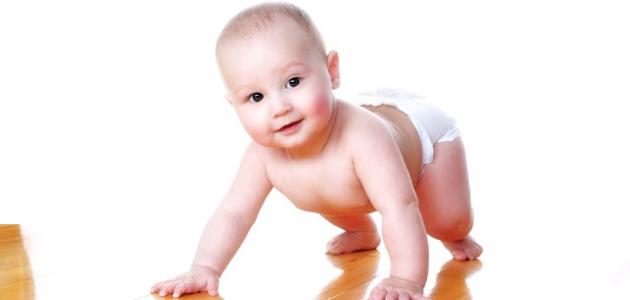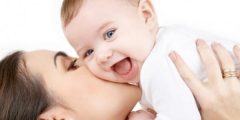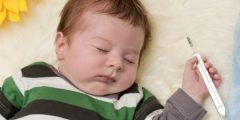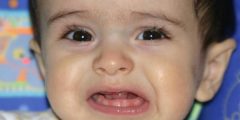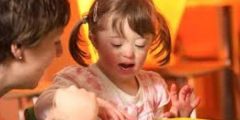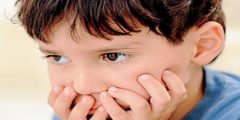Stages of child development from month to year
The first year of a child’s life is one of the beautiful and wonderful moments that parents experience with their children. During the first months after his birth, the infant will depend completely on his parents to obtain care and meet his needs. Within 12 months, the newborn will begin to adapt to the new world, and will turn into a child. A young child begins to walk and talk and shows the first signs of independence. Surprisingly, the rate of growth of children during the first year of their lives is rapid, including noticeable changes in height and weight gain. Children also go through major stages of development and achievement, which are referred to as developmental milestones. (In English: Developmental milestones).
The child's physical development during the first year
The term physical growth is usually defined as an increase in body size. Such as height or stature, weight, and the size of the organs. It is worth noting that the growth rate of children from birth until they reach one or two years is rapid and noticeable, then their growth begins to slow down, and the child’s need for calories decreases, and the parents may notice a decrease in the child’s appetite.
Wight:
In fact, most newborns who are in good health increase their weight by about double when they reach the first four months of their lives, and their weight has increased by about three times by the time they reach one year of age. It should be noted that every child grows at his own pace, and may Fluctuations and growth changes also occur in the child, represented by a change in the speed of weight gain. For this reason, the child may not remain within the same percentile (in English: Percentile) for weight or height every time he is brought to the doctor, and if the child was large at birth - That is, higher than the normal weight range - he is likely to grow very slowly during the first few months, and his weight is likely to become close to the weight of other children his age by six to eight months of age. However, if the child is small due to premature birth, he may reach To normal weight during the first year of his life, and it can be said that the best way to track the child’s growth and weight gain is to visit the doctor periodically, which includes subjecting the child to regular examinations to record indicators related to the child’s growth and ensure the health of his growth, and this includes measuring his weight, length, and head circumference. So that the measurements are compared with standard growth charts.
Read also:Baby developments in the third month
Length
The height of young children who cannot stand is measured by placing them on a flat surface while lying on their backs, and a special height measuring device is often used for this purpose. Such as a height measuring table known as a stadiometer. As for children who can stand, their height is measured using a vertical measuring device. In fact, the extent of the natural increase in children’s height varies from one age group to another. Others, for example; The length of an infant increases naturally by about 30% by the time he reaches the age of 5 months and by more than 50% by the age of one year. In general, the infant gains about 25 centimeters during the first year of life, and his length upon completion of five years is twice his height at birth.
Head circumference
Head circumference can be defined as measuring the circumference of the largest area of the child’s head, and this measurement is one of the important routine examinations, as the size of the head reflects the size of the brain, and this in itself allows doctors to know whether the child’s brain is growing at a normal rate or not. The process of taking the reading is done after placing the measuring tape over the eyebrows, ears, and around the back of the head. The doctor records the measurements and compares them with previous measurements, and with normal readings for children of the same age, if the head circumference measurement is higher than normal or the size of the head increases faster. Normally, this may indicate the presence of some health problems, including the accumulation of fluid in the brain, which is called hydrocephalus. However, in cases where the child’s head circumference measurement is less than normal or the rate of brain growth is slow, this may indicate This is because there is a defect in brain development, and this condition is called microcephaly.
Read also:What is the treatment for constipation in children?
Teeth eruption
Teeth begin to appear in most children when they reach the age of six months, so that the lower front teeth, or what are called the bottom central incisors (in English: Bottom central incisors), are the first to appear in the child’s mouth, and as a general rule, for every six months of the child’s age, about four appear. Teeth. In most cases, tooth development during the first year of a child’s life includes the development of only the central and lateral incisors. In general, tooth eruption occurs earlier in girls than in boys.
Baby reactions during the first year
Reflexes can be defined as a response to a stimulus or movements that occur involuntarily. Some spontaneous movements can be observed that occur as part of the child’s normal activity, while other reactions may occur in response to some procedures. The doctor examines the child’s reactions to determine Whether the brain and nervous system are working well or not, it is worth mentioning that some reactions are limited to specific periods of the child’s development, and here is a mention of some of the natural reactions that appear in newborns:
Nipple latch-on reaction
The nipple latch-on reflex or rooting reflex helps newborns in the breastfeeding process. Whether breastfeeding or through a milk bottle, the infant moves his head towards anything that touches the corner of his mouth until he finds it, and this type of reaction often continues until the fourth month of the child’s life.
Read also:When does childhood end?
Reflex sucking
As we mentioned previously, the nipple latch-on reflex helps the child in the breastfeeding process. Automatically, when touching the roof of the child’s mouth, the child will begin to suck. The reaction that enables the child to prepare for sucking is known scientifically as the sucking reflex (in English: Sucking reflex). The development of this type of reaction begins during the thirty-second week of pregnancy, and does not fully develop until the thirty-sixth week of pregnancy. Therefore, children who are born prematurely have a weak or immature ability to suck milk, and it can be said that children also have a reaction. The hand-to-mouth reflex goes along with nipple latch and sucking. The baby may suck the fingers or hands, and sometimes the fetus can be seen sucking its thumb during the ultrasound scan.
Moreau's reaction
The Moro reflex helps monitor the infant's reaction. Such as stretching and bending movements when exposed to external stimuli. To detect that the child has this type of reaction, the doctor gently raises the child’s head and then suddenly releases the head. The doctor must support the head after releasing it, and the child’s natural response is to open his hands and extend his upper limbs. This is followed by the upper limbs bending forward in a position resembling an embrace, in addition to the baby’s audible crying. This type of reaction usually goes away after three or four months of the infant’s life.
Palmar grip reflex
The palmar grasping reflex (in English: Grasping reflex) occurs when the finger or any other object is placed in the infant's open palm. The infant's hand will contract around the object or finger, and when trying to remove it, this will result in the child tightening his hand. This indicates that newborn infants have a strong grip, and this can be seen when trying to lift him if the child holds the person’s two fingers with both hands.
Gallant reflex
The infantile Galant reflex, also known as the Galant reflex, occurs when the doctor places the infant on his stomach and then begins to tap or run his finger along the side of the infant's spine. This causes the infant to bend sideways toward the location that was stimulated, with a similar movement. For dance movement.
Sudden landing reflex
The sudden landing reflex, parachute reflex, or parachute reflex (in English: Parachute Reflex) can be observed in older infants, when the child is carried in an upright position and then the child’s body is quickly rotated to fall towards the ground, as is the case in a falling position. In this case, the child extended his arms forward as if to avoid falling, and it is worth noting that this type of reaction appears long before walking.
Developmental milestones for children
A child often begins to develop many skills during the first year of his life that he will use for the rest of his life. It should be noted that the rate of development varies from one child to another. Many children may be classified within the normal category despite being slightly behind others in acquiring some skills. They may This category also includes individuals who are ahead of others in certain ways, and it is worth noting that children who are born prematurely do not follow the developmental foundations of children who were born on time, so it is likely that children who were born one month early will take an additional month to catch up with their peers. The most prominent skills can be described as follows:
- Gross motor skills: (English: Gross motor), which includes sitting, starting to walk, crawling, and controlling head movement.
- Fine motor skills: (English: Fine motor), such as picking up a piece of breakfast cereal between your thumb and finger, or holding a spoon.
- language skills: (in English: Language), and it begins with the child making sounds, teaching him some words, and understanding what the people around him are saying.
- Sensory skills: (English: Sensory), which includes the five senses; These are taste, smell, touch, hearing, and sight.
- social skills: (In English: Social skills), which are represented by the child gaining the ability to play with family members and other children.
From birth to three months
Caring for the child at the beginning of his life is limited to breastfeeding him, changing his diapers, and soothing him if he starts crying, but soon the child begins to grow, develop, and acquire skills during his life, and this requires providing more care, and the following is a statement of the most prominent skills that the child will begin to acquire from Birth to three months of age:
- Motor skills: (In English: Motor skills), at first the child’s ability to control the movement of his head will be weak, wobbly, and unstable, and with the passage of time the child will be able to raise his head and chest when lying on his stomach, in addition to gaining the ability to stretch and kick his legs in that position, and if someone presents The child has a toy that he may hold for a few moments.
- communication: (In English: Communication), when the child reaches the age of two months, the child may coo and repeat verbal sounds when someone talks to him or plays with him.
- Vision: While breastfeeding, the baby will likely focus on his mother's face, especially the eyes. By one month old, the baby will prefer to look at clear patterns with sharply contrasting colors or black and white. At about two months old, the baby's eyes will become more coordinated, allowing him to track objects. Around him, the child will also begin to recognize familiar objects and people from afar.
- Hearing: The child is sensitive to sounds, especially high-pitched ones. It is expected that the child will begin to respond to the tone of his mother’s voice by smiling and gargling. The child will also begin to turn toward the sounds.
At the beginning of their lives, children depend on crying as a means of communication between them and their mothers. The child’s crying may be an indication of his feeling of discomfort, hunger, or pain, or in order to attract attention. Most newborns reach peak crying around the sixth week of their lives, and then Their crying begins to decrease, and when they reach the age of three months, children may usually cry for a total of about 60 minutes per day. It is worth noting that some children cry more than others, and this may be an indication that they suffer from colic, and crying is characterized in cases of colic. It begins and ends without a clear reason for this, and continues for at least three hours a day, and occurs at least three days a week, and continues for a period of three weeks to three months. The mother often feels a little frustrated and exhausted when she finds it difficult to calm her child. But once the child is held, he may feel safe and reassured, and this method is often effective for calming the child.
From the fourth to the sixth month
The development of the infant’s skills during the period between the fourth and sixth months can be described as follows:
- Motor skills: By the age of six months, the child may be able to raise his head and chest while lying on his stomach, and he may be able to support himself on his extended arms, as well as roll over, and when the child is placed on his back, he will also be able to lift his head from the pillow and raise his feet to the extent that He can hold them with his hands, if his hands are attached to an object. The child can also pull himself to sit with his head upright and his back straight. He can stand on his feet. When a toy is placed out of his reach, the child will try to reach it. He has the ability to move things from One hand to the other, bringing objects to his mouth, and being able to grasp objects with his entire hand.
- the language: Most six-month-old babies are able to vocalize using single and double words, such as “mama” and “dada.”
- Vision and hearing: The child's vision improves during this stage of his life to the point that he is able to track a circular object for a distance ranging from one to five metres. He can also distinguish and follow the sounds around him.
- social skills: In this age group, the child is able to recognize the family members around him, distinguish people who are strange to him and whose faces are unfamiliar to him, and may show a little shyness and confusion towards strangers. Also, during this stage the child is able to laugh when he is happy, and cry when he is upset. Enjoying playing, the child is constantly alert, excited, alert, and active, and the child may also take the initiative to raise his arms to be carried.
From the fourth month to the ninth
The child grows larger and develops his motor skills such that he can crawl, stand firmly, sit without support, and lean on an object so that he can stand on his own. They also develop the ability to distinguish strangers from others, as they may show signs of fear when there is an unfamiliar stranger present to them. He clings to his parents or to the people he is accustomed to, and has his favorite toys. You may notice that he imitates the voices and gestures of others. He begins to understand the meaning of the word “no.” He also makes many different sounds. He is able to use his fingers to point to things, and he can move things easily on the one hand. To another, he searches for things that are hidden in front of him, and he can pick things up, and monitor the path of things when they fall.
From the tenth month until the age of one year
A child at this age can stand on his own without anyone’s help and walk while leaning on things with one hand. He may also begin trying to take his first steps alone. He uses his thumb and index finger precisely to pick up things. He can hold a block or cube in each hand, or he may hit them together. He can put Two cubes on top of each other. He also uses both hands to pick up food and put it in his mouth. Regarding communication and language skills, he may say one or two words in addition to the words “mama” and “dada,” and point to things. He may begin to babble and make sounds that may mimic the words he hears. He begins to understand simple questions, and some show their love for reading and looking at comic books, and carry out commands. When he acquires a new skill, such as walking and standing, he feels proud, and begins to imitate older children and adults, and may cry at the actions of others. Such as his crying when his mother leaves the room, and he repeats behaviors that lead to the desired result, such as dropping a toy from the edge of a table so that whoever is sitting with him can pick it up and return it to the edge.
